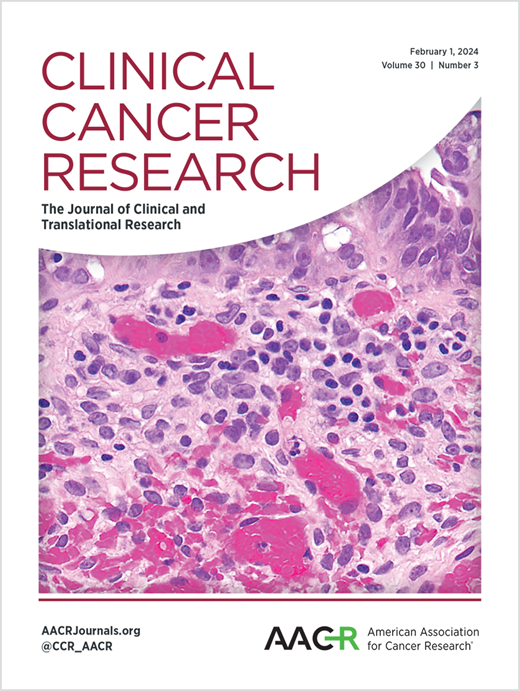A single arm phase 2 trial of doxorubicin plus zalifrelimab (anti-CTLA-4 antibody) and balstilimab (anti-PD-1 antibody) in advanced/metastatic soft tissue sarcomas
IF 10
1区 医学
Q1 ONCOLOGY
引用次数: 0
Abstract
Purpose: Doxorubicin is standard chemotherapy for metastatic soft tissue sarcomas (STSs) but also enhances innate/adaptive immune responses by inducing immunogenic cell death. Most STSs are immune “cold” tumors that do not respond to immune checkpoint inhibitors (ICIs) blocking PD-1 and CTLA-4. We hypothesized that concurrent doxorubicin would improve tumor immunogenicity and boost efficacy of ICIs in STS. Patients and Methods: We conducted a single arm, phase 2 trial of doxorubicin plus zalifrelimab (anti-CTLA-4 antibody) and balstilimab (anti-PD-1 antibody) for advanced/metastatic STS patients without prior doxorubicin or ICIs (NCT04028063). The study was a Simon minimax two-stage design to accrue 28 patients evaluable for primary endpoint of progression-free survival rate at six months (PFS6mo) by RECIST 1.1. The study aimed to improve PFS6mo by 20% over historical null rate of 43.4% with doxorubicin monotherapy. Secondary endpoints included objective response rate (ORR), disease control rate (DCR), overall survival (OS), duration of response (DOR), and adverse events (AEs). Results: PFS6mo for 28 evaluable patients was 46.4% [95% CI 27.5-66.1] and not superior to null rate, with median PFS of 25.3 weeks [95% CI 24.0-42]. Best ORR was 33.3% [95% CI 17.3-52.8] with DCR of 80.0% [95% CI 61.4-92.3], including STS types unlikely to respond to doxorubicin or ICIs alone. Grade 3/4 treatment-related AEs occurred in 45% of patients, with immune-mediated AEs requiring immunosuppression in 9%. Conclusions: Although the study did not meet the predefined endpoint for PFS improvement, promising signals of efficacy warrant future investigation including response/resistance biomarkers to inform patient selection.阿霉素联合zalifrelimab(抗ctla -4抗体)和balstilimab(抗pd -1抗体)治疗晚期/转移性软组织肉瘤的单组2期试验
目的:阿霉素是转移性软组织肉瘤(STSs)的标准化疗药物,但也通过诱导免疫原性细胞死亡来增强先天/适应性免疫反应。大多数STSs是免疫“冷”肿瘤,对阻断PD-1和CTLA-4的免疫检查点抑制剂(ICIs)没有反应。我们假设并发多柔比星可以改善肿瘤免疫原性并提高STS中ICIs的疗效。患者和方法:我们对没有阿霉素或ICIs (NCT04028063)的晚期/转移性STS患者进行了一项单组2期试验,阿霉素联合zalifrelimab(抗ctla -4抗体)和balstilimab(抗pd -1抗体)。该研究采用Simon minimax两期设计,共纳入28例患者,可通过RECIST 1.1评估6个月无进展生存率(PFS6mo)的主要终点。该研究旨在使PFS6mo比阿霉素单药治疗43.4%的历史零率提高20%。次要终点包括客观缓解率(ORR)、疾病控制率(DCR)、总生存期(OS)、缓解持续时间(DOR)和不良事件(ae)。结果:28例可评估患者的PFS6mo为46.4% [95% CI 27.5-66.1],不优于零,中位PFS为25.3周[95% CI 24.0-42]。最佳ORR为33.3% [95% CI 17.3-52.8], DCR为80.0% [95% CI 61.4-92.3],包括STS类型单独使用阿霉素或ICIs不太可能产生反应。45%的患者发生3/4级治疗相关不良事件,9%的患者发生免疫介导的不良事件,需要免疫抑制。结论:尽管该研究没有达到PFS改善的预定终点,但有希望的疗效信号值得未来的研究,包括反应/耐药生物标志物,以告知患者选择。
本文章由计算机程序翻译,如有差异,请以英文原文为准。
求助全文
约1分钟内获得全文
求助全文
来源期刊

Clinical Cancer Research
医学-肿瘤学
CiteScore
20.10
自引率
1.70%
发文量
1207
审稿时长
2.1 months
期刊介绍:
Clinical Cancer Research is a journal focusing on groundbreaking research in cancer, specifically in the areas where the laboratory and the clinic intersect. Our primary interest lies in clinical trials that investigate novel treatments, accompanied by research on pharmacology, molecular alterations, and biomarkers that can predict response or resistance to these treatments. Furthermore, we prioritize laboratory and animal studies that explore new drugs and targeted agents with the potential to advance to clinical trials. We also encourage research on targetable mechanisms of cancer development, progression, and metastasis.
 求助内容:
求助内容: 应助结果提醒方式:
应助结果提醒方式:


